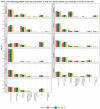COVID-19 vaccine acceptance and hesitancy in low- and middle-income countries
- PMID: 34272499
- PMCID: PMC8363502
- DOI: 10.1038/s41591-021-01454-y
COVID-19 vaccine acceptance and hesitancy in low- and middle-income countries
Abstract
Widespread acceptance of COVID-19 vaccines is crucial for achieving sufficient immunization coverage to end the global pandemic, yet few studies have investigated COVID-19 vaccination attitudes in lower-income countries, where large-scale vaccination is just beginning. We analyze COVID-19 vaccine acceptance across 15 survey samples covering 10 low- and middle-income countries (LMICs) in Asia, Africa and South America, Russia (an upper-middle-income country) and the United States, including a total of 44,260 individuals. We find considerably higher willingness to take a COVID-19 vaccine in our LMIC samples (mean 80.3%; median 78%; range 30.1 percentage points) compared with the United States (mean 64.6%) and Russia (mean 30.4%). Vaccine acceptance in LMICs is primarily explained by an interest in personal protection against COVID-19, while concern about side effects is the most common reason for hesitancy. Health workers are the most trusted sources of guidance about COVID-19 vaccines. Evidence from this sample of LMICs suggests that prioritizing vaccine distribution to the Global South should yield high returns in advancing global immunization coverage. Vaccination campaigns should focus on translating the high levels of stated acceptance into actual uptake. Messages highlighting vaccine efficacy and safety, delivered by healthcare workers, could be effective for addressing any remaining hesitancy in the analyzed LMICs.
© 2021. The Author(s).
Conflict of interest statement
The authors declare no competing interests.
Figures





Comment in
-
Understanding COVID-19 vaccine hesitancy.Nat Med. 2021 Aug;27(8):1338-1339. doi: 10.1038/s41591-021-01459-7. Nat Med. 2021. PMID: 34272500 No abstract available.
-
Researchers fear growing COVID vaccine hesitancy in developing nations.Nature. 2022 Jan;601(7892):174-175. doi: 10.1038/d41586-021-03830-7. Nature. 2022. PMID: 34949861 No abstract available.
References
-
- Draft landscape and tracker of COVID-19 candidate vaccines (World Health Organization, 2021); https://www.who.int/publications/m/item/draft-landscape-of-covid-19-cand...
-
- COVID-19 Vaccine Tracker (McGill COVID19 Vaccine Tracker Team, 2021); https://covid19.trackvaccines.org/vaccines/
-
- Global attitudes: COVID-19 vaccines (Ipsos World Economic Forum, 2021); https://www.ipsos.com/en-ro/global-attitudes-covid-19-vaccine-january-2021
Publication types
MeSH terms
Substances
Grants and funding
LinkOut - more resources
Full Text Sources
Medical

